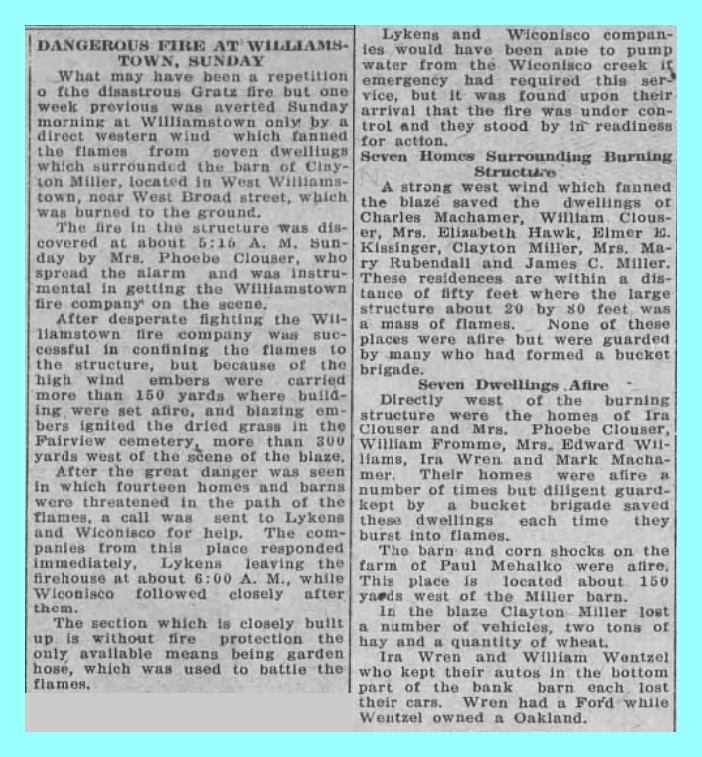
1924 was a year of disastrous and almost disastrous files in the Lykens Valley area. This fire, which occurred in Williamstown, Dauphin County, Pennsylvania, in November 1924, almost burned around fourteen structures. It was mostly confined to the barn of Clayton Miller, but it took herculean efforts on the part of several area fire department and scores of residents with buckets to save the other buildings.
In the article that appeared in the Lykens Standard, November 14, 1924, no cause was given for this fire. Some of the other big fires were of suspicious origin, and there were suggestions that Ku Klux Klan cross burnings – fires that had not been completely extinguished, resulted in the embers re-igniting in the early morning hours when the wind picked up.
DANGEROUS FIRE AT WILLIAMSTOWN
What may have been a repetition of the disastrous Gratz fire but one week previous was averted Sunday morning at Williamstown only by a direct western wind which fanned the flames from seven dwellings which surrounded the barn of Clayton Miller, located in West Williamstown, near West Broad Street, which was burned to the ground.
The fire in the structure was discovered at about 5:15 A. Am. Sunday by Mrs. Phoebe Clouser, who spread the alarm and was instrumental in getting the Williamstown Fire Company on the scene.
After desperate fighting the Williamstown fire company was successful in confining the flames to the structure, but because of the high wind embers were carried more than 150 yards where buildings were set afire, and blazing embers ignited the dried grass in the Fairview Cemetery, more than 300 yards west of the scene of the blaze.
After the great danger was seen in which fourteen homes and barns were threatened in the path of the flames, a call was sent to Lykens and Wiconisco for help. The companies from this place [Lykens] responded immediately, Lykens leaving the firehouse at about 6:00 A. M., while Wiconisco followed closely after them.
The section which is closely built up is without fire protection the only available means being garden hose, which was used to battle the flames.
Lykens and Wiconisco companies would have been able to pump water from the Wiconisco Creek iemergency had required this service, but it was found upon their arrival that the fire was under control and they stood by in readiness for action.
Seven Homes Surrounding Burning Structure
A strong west wind which fanned the blaze saved the dwellings of Charles Machamer, William Clouser, Mrs. Elizabeth Hawk, Elmer E. Kissinger, Clayton Miller, Mrs. Mary Rubendall and James C. Miller. These residences are within a distance of fifty feet where the large struture about 20 by 80 feet was a mass of flames. None of these places were afire but were guarded by many who had formed a bucket brigade.
Seven Dwellings Afire
Directly west of the burning structure were the homes of Ira Clouser and Mrs. Phoebe Clouser, William Fromme, Mrs. Edward Williams, Ira Wren and Mark Machamer. Their homes were afire a number of times but diligent guard kept by a bucket brigade saved these building each time they burst into flames.
The barn and corn shocks on the farm of Paul Mehalko were afire. This place is located about 150 yards west of the Miller barn.
In the blaze Clayton Miller lost a number of vehicles, two tons of hay and a quantity of wheat.
Ira Wren and William Wentzel who kept their autos in the bottom part of the bank barn each lost their cars. Wreen had a Ford while Wentzel owned an Oakland.
________________________________________
News article from Newspapers.com
Corrections and additional information should be added as comments to this post.